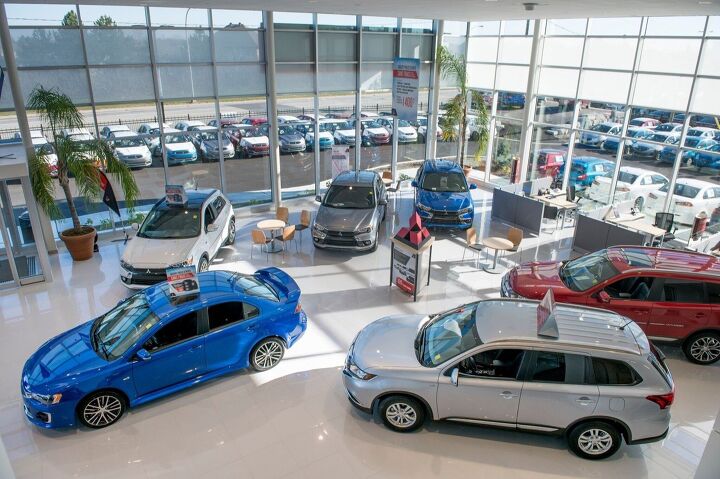Mitsubishi Doubles Warranty Length in Canada, but Nothing Lasts Forever
♪ Stand by your cars (temporarily),
Mitsubishi Canada has decided to double the length of its comprehensive warranty and the duration of its roadside assistance, standing by its products like never before, and like nobody else, in celebration of the company’s 100th anniversary.
The celebration won’t last. Mitsubishi’s willingness to stand by its products for a decade goes only so far. One-upping Herman Cain’s 9-9-9 campaign pledge, the “10-10-10” plan — 10-year/160,000-kilometer comprehensive coverage and 10-year/160,000-kilometer roadside assistance, in addition to the existing 10-year/160,000-kilometer powertrain warranty — is a limited-time promotion.
“For the summer of 2017, we’re making the best warranty in the business even better,” says Mitsubishi Motor Sales of Canada CEO Tony Laframboise.
Thus, this is the summer of Outlanders, Canada. The summer of RVRs, Canada. The summer, I dare say, of Mirage.
Mitsubishi says the summer’s 10-10-10 warranty coverage “reinforces the company’s Built Better, Backed Better reputation.” If so, then what message is reinforced when Mitsubishi Canada rolls back the comprehensive coverage and roadside assistance on or around Labour Day weekend?
The coverage also doesn’t go so far as to include a pair of niche models: existing i-MiEV electric cars and remaining Mitsubishi Lancer Evolutions. Probably a wise choice.
Mitsubishi’s attempt to attract attention to its lineup is a necessary one given the dearth of attention-grabbing models. Canadian sales climbed to record levels in 2014 but have fallen slightly behind that pace in the ensuing years. Mitsubishi Canada earns substantially better market share than its U.S. partner: 1.1 percent, year-to-date, compared with 0.6 percent south of the border.
Mitsubishi, of course, owned 2 percent of the U.S. market in 2002, when volume peaked. That was the year Mitsubishi became a full-line automaker in Canada. Within a decade, sales had doubled.
But Mitsubishi no longer markets a midsize car — the Galant earned its final Canadian sales in 2011, six years after the Diamante died, one year before the Endeavor was put out to pasture. The large Montero SUV, which would surely be a helpful vehicle for Mitsubishi to have in its showroom today, departed after the 2006 model year, a year after the Montero Sport. The Eclipse, which earned more than 2,000 sales in 2006, was gone by 2013. Mitsubishi’s sporting heritage flew out the window with the discontinuation of the Lancer Evolution, and the car on which it’s based will suffer through a 2018 model year and then end its run, leaving Mitsubishi without a competitor in Canada’s vast compact car category.
With the Outlander Plug-in forever delayed and the Eclipse Cross not here yet, Mitsubishi wants, nay, needs Canadians to hear positive Mitsubishi news.
At least for as long as a Canadian summer lasts.
[Image: Mitsubishi]
Timothy Cain is a contributing analyst at The Truth About Cars and Autofocus.ca and the founder and former editor of GoodCarBadCar.net. Follow on Twitter @timcaincars.
More by Timothy Cain
Latest Car Reviews
Read moreLatest Product Reviews
Read moreRecent Comments
- ToolGuy First picture: I realize that opinions vary on the height of modern trucks, but that entry door on the building is 80 inches tall and hits just below the headlights. Does anyone really believe this is reasonable?Second picture: I do not believe that is a good parking spot to be able to access the bed storage. More specifically, how do you plan to unload topsoil with the truck parked like that? Maybe you kids are taller than me.
- ToolGuy The other day I attempted to check the engine oil in one of my old embarrassing vehicles and I guess the red shop towel I used wasn't genuine Snap-on (lots of counterfeits floating around) plus my driveway isn't completely level and long story short, the engine seized 3 minutes later.No more used cars for me, and nothing but dealer service from here on in (the journalists were right).
- Doughboy Wow, Merc knocks it out of the park with their naming convention… again. /s
- Doughboy I’ve seen car bras before, but never car beards. ZZ Top would be proud.
- Bkojote Allright, actual person who knows trucks here, the article gets it a bit wrong.First off, the Maverick is not at all comparable to a Tacoma just because they're both Hybrids. Or lemme be blunt, the butch-est non-hybrid Maverick Tremor is suitable for 2/10 difficulty trails, a Trailhunter is for about 5/10 or maybe 6/10, just about the upper end of any stock vehicle you're buying from the factory. Aside from a Sasquatch Bronco or Rubicon Jeep Wrangler you're looking at something you're towing back if you want more capability (or perhaps something you /wish/ you were towing back.)Now, where the real world difference should play out is on the trail, where a lot of low speed crawling usually saps efficiency, especially when loaded to the gills. Real world MPG from a 4Runner is about 12-13mpg, So if this loaded-with-overlander-catalog Trailhunter is still pulling in the 20's - or even 18-19, that's a massive improvement.


































Comments
Join the conversation
I remain mystified as to why Nissan didn't just fold the brand in NA and have Nissan dealerships handle parts distribution and the remaining warranty.
Easy to extend a warranty when the future of your business is uncertain. They might as well make them lifetime.